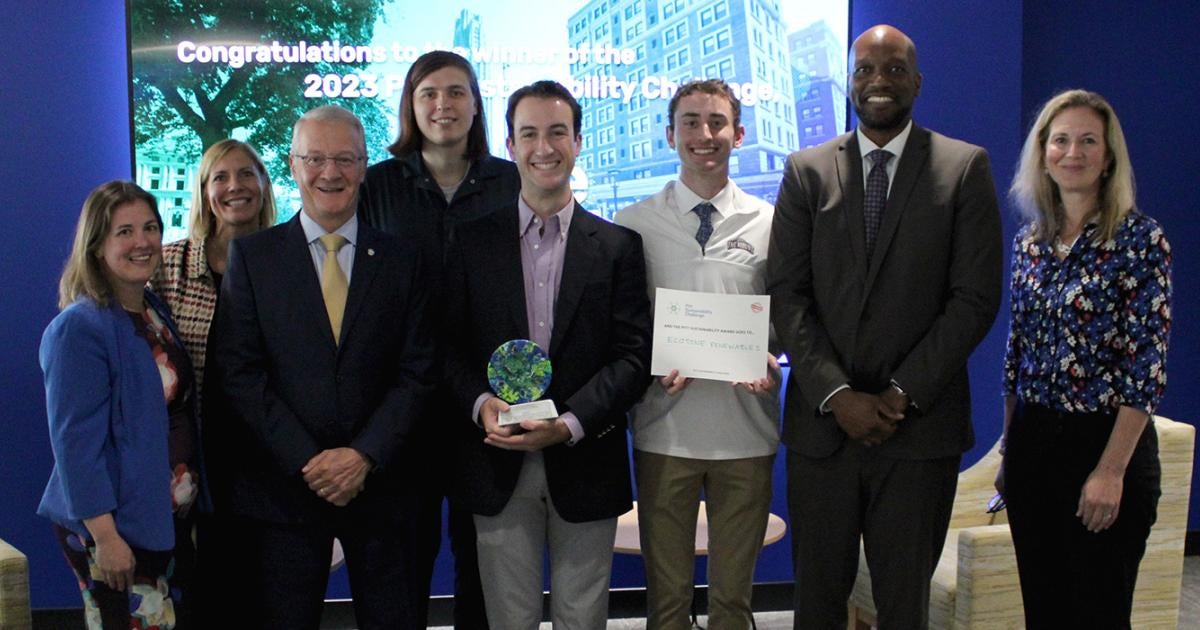The Pitt Sustainability Challenge winner has a solution for food waste on campus
The Pitt Sustainability Challenge winner has a solution for food ... University of Pittsburgh


Ecotone Renewables Wins Pitt Sustainability Challenge

Introduction
Ecotone Renewables emerged as the winner of the Pitt Sustainability Challenge Finalist Pitch Event, securing a grant of $300,000. This funding will be utilized to implement their anaerobic digestion technology on or near Pitt campuses. The aim is to divert carbon emissions by converting local food waste into nutrient-dense, ready-to-use fertilizer.
Supporting Pitt’s Carbon Neutrality Goal
All five finalists presented initiatives that align with Pitt’s objective of achieving carbon neutrality by 2037. Each proposal offered a unique approach, including ideas to replace inefficient laboratory freezers and repurpose abandoned mines for temperature control. To ensure a comprehensive range of solutions, Pitt collaborated with Carrot, a globally recognized organizer for creative challenges.
The Challenge Process
Pitt’s executive director of sustainability, Aurora Sharrard, emphasized the inclusive nature of the challenge process. The goal was to create an open opportunity that welcomed diverse ideas. Proposals varied in their focus, with some emphasizing research aspects, others integrating into the student experience, and some specifically targeting Pittsburgh and regional campuses. The challenge process allowed for flexibility and innovation.
Advancement of Finalists’ Ideas
Although only one project could be selected as the winner, Pitt remains committed to advancing the ideas presented by all the finalists. Sharrard expressed hope that each proposal would progress in some way. The university boasts an engaged student population passionate about sustainability, and their ideas are actively implemented on a daily basis.
Impact of the Challenge
Jaison Morgan, CEO of Carrot, highlighted the broader impact of contests like the Pitt Sustainability Challenge. He likened it to running a survey, where multiple solutions are presented. Additionally, participants have the opportunity to engage with stakeholders and experts, leading to the implementation of their plans beyond the challenge itself.
Partnership with Ecotone Renewables
Sharrard is already working on the logistics of the University’s partnership with Ecotone Renewables. Plans are underway to integrate the proposed anaerobic digesters across Pitt campuses within the next 1-2 years. This collaboration will further contribute to Pitt’s sustainable practices.
Getting Involved in Advancing Carbon Neutrality
Individuals interested in contributing to Pitt’s carbon neutrality efforts do not have to wait for the arrival of the first ZEUS digester on campus later this year. Visit Pitt Sustainability to explore opportunities for students, faculty, and staff to get involved.
SDGs, Targets, and Indicators
1. Which SDGs are addressed or connected to the issues highlighted in the article?
- SDG 7: Affordable and Clean Energy
- SDG 9: Industry, Innovation, and Infrastructure
- SDG 12: Responsible Consumption and Production
- SDG 13: Climate Action
- SDG 17: Partnerships for the Goals
The article discusses the Pitt Sustainability Challenge, which aims to support Pitt’s goal of reaching carbon neutrality by 2037. This goal is directly related to SDG 13: Climate Action. The article also mentions the implementation of anaerobic digestion technology to convert food waste into fertilizer, which is connected to SDG 12: Responsible Consumption and Production. Additionally, the article highlights the partnership between Pitt and Carrot, indicating a focus on SDG 17: Partnerships for the Goals. The use of innovative technology and ideas mentioned in the article align with SDG 9: Industry, Innovation, and Infrastructure. Lastly, the mention of carbon emissions reduction and clean energy solutions relates to SDG 7: Affordable and Clean Energy.
2. What specific targets under those SDGs can be identified based on the article’s content?
- SDG 7.2: Increase the share of renewable energy in the global energy mix
- SDG 9.4: Upgrade infrastructure and retrofit industries to make them sustainable
- SDG 12.4: By 2020, achieve the environmentally sound management of chemicals and all wastes throughout their life cycle
- SDG 13.2: Integrate climate change measures into national policies, strategies, and planning
- SDG 17.16: Enhance the global partnership for sustainable development
The article mentions the implementation of anaerobic digestion technology, which contributes to increasing the share of renewable energy (SDG 7.2) by converting food waste into energy. The retrofitting of Pitt campuses with anaerobic digesters aligns with the target of upgrading infrastructure and making it sustainable (SDG 9.4). The conversion of food waste into nutrient-dense fertilizer addresses the target of achieving environmentally sound waste management (SDG 12.4). The goal of reaching carbon neutrality by 2037 demonstrates the integration of climate change measures into planning (SDG 13.2). Lastly, the partnership between Pitt and Carrot reflects the enhancement of global partnerships for sustainable development (SDG 17.16).
3. Are there any indicators mentioned or implied in the article that can be used to measure progress towards the identified targets?
- Percentage increase in renewable energy share
- Number of infrastructure upgrades and retrofits
- Amount of food waste diverted and converted into fertilizer
- Integration of climate change measures in policies and planning
- Number of partnerships formed for sustainable development
The article does not explicitly mention specific indicators. However, progress towards the identified targets can be measured using indicators such as the percentage increase in renewable energy share, the number of infrastructure upgrades and retrofits, the amount of food waste diverted and converted into fertilizer, the integration of climate change measures in policies and planning, and the number of partnerships formed for sustainable development.
4. Table: SDGs, Targets, and Indicators
| SDGs | Targets | Indicators |
|---|---|---|
| SDG 7: Affordable and Clean Energy | 7.2: Increase the share of renewable energy in the global energy mix | Percentage increase in renewable energy share |
| SDG 9: Industry, Innovation, and Infrastructure | 9.4: Upgrade infrastructure and retrofit industries to make them sustainable | Number of infrastructure upgrades and retrofits |
| SDG 12: Responsible Consumption and Production | 12.4: By 2020, achieve the environmentally sound management of chemicals and all wastes throughout their life cycle | Amount of food waste diverted and converted into fertilizer |
| SDG 13: Climate Action | 13.2: Integrate climate change measures into national policies, strategies, and planning | Integration of climate change measures in policies and planning |
| SDG 17: Partnerships for the Goals | 17.16: Enhance the global partnership for sustainable development | Number of partnerships formed for sustainable development |
Behold! This splendid article springs forth from the wellspring of knowledge, shaped by a wondrous proprietary AI technology that delved into a vast ocean of data, illuminating the path towards the Sustainable Development Goals. Remember that all rights are reserved by SDG Investors LLC, empowering us to champion progress together.
Source: pitt.edu

Join us, as fellow seekers of change, on a transformative journey at https://sdgtalks.ai/welcome, where you can become a member and actively contribute to shaping a brighter future.







